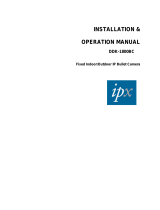
COMMON APPLICATIONS AND OTHER INSTALLATION DETAILS
The DDK-719 Roof Clip can be used for a variety of at roof applica-
tions, including on EPDM, TPO and PVC. This clip can be installed on
any at surfuce using the appropriate adhesive. Mark out your de-
sired installation pattern and clip locations. After the clip areas have
been cleaned, the clips can be installed using the same methods as
described in previous sections. The DDK-179 clip can also be used on
the back wall of open-face vertical downspounts to keep a single or
double run of cable secure.
The DDK-719 Roof Clip can be installed on metal surfaces using meth-
acrylate adhesives. One popular choice is SureBond 190*. Clean the
substrate area thoroughly before installing the clip to ensure a good
adhesive bond. Place clip on the prepared surface and press down
until the adhesive ows through the holes. Do not trim back the ad-
hesive as the excess ow through helps hold the clip. Allow adhesive
to cure per manufacturer’s specications before installing heating
cable. Always verify the best adhesive for your project by asking the
roong manufacturer.
For more information visit www.radiantsolutionscompany.com
Freeze
Protection
Products
SOLUTIONS COMPANY
RADIANT
The DDK-719 clip can be installed using nails or screws in conjuction with the MKS-1022-2 Butyl Pad where a high-bond, water-resistant
connection is desired. These butyl pads are sized to t the DDK clips and offer superior water sealing and adhesive qualities that allow the
DDK-719 clips to be used on a large variety of surfaces including wood, glass, plastic, metal, rubber and stone. Follow these steps:
INSTALLING CLIPS USING FASTENERS AND MKS-1022-2 BUTYL PADS (3”x 3”x 1/8”)
HEAT CABLE ROOF CLIP INSTALLATION MANUAL
DDK-719 LARGE GLUE-DOWN/NAIL-DOWN
Clean 4”x4” area with rubbing alcohol or other
appropriate solution. Let Dry. Peel backing
paper off Butyl Pad and apply appropriate
adhesive to area where clip will be installed.
Push clip down onto adhesive. Allow some
adhesive to ooze out of holes in the clip as
this will enhance the adhesive bond.
After adhesive has curred (usually 12-24
hours), place the heat cable into the cradle
on the clip and pinch to close using your
ngers or a pliers.
Clean & Stick
1Place Clip
2Pinch
3
Flat Roofs, Scuppers & More Metal Roofs


